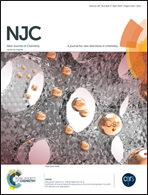Synthesis and properties of benzo[c]-, pyrrolo[3,4-c]-, and thieno[3,4-c]-pyrrole-4,6-dione copolymers
Abstract
New π-conjugated alternating donor–acceptor polymers, BPD–DTT and PPD–DTT, based respectively on benzo[c]pyrrole-4,6-dione (BPD) and pyrrolo[3,4-c]pyrrole-4,6-dione (PPD) acceptor structures with the 2,5-dithienylthieno[3,2-b]thiophene (DTT) donor structure were synthesized via Stille cross-coupling polymerization to study their physical and optoelectronic properties. For comparison, an analogous polymer, TPD–DTT, derived from thieno[3,4-c]pyrrole-4,6-dione (TPD) was also prepared by the same approach. These polymers displayed reasonably good solubility in common organic solvents (e.g., THF, toluene, etc.), and were thermally stable to about 350 °C in nitrogen or air. Both BPD–DTT and PPD–DTT showed blue shifts in their UV-vis absorptions and photoluminescence compared with those of TPD–DTT, suggesting that both possess lower degrees of π-delocalization than TPD–DTT, and thus shorter effective π-conjugation lengths and higher air stability as evidenced from their lower HOMO energy levels. Optical band gaps of 1.61 eV, 1.82 eV, and 1.73 eV and HOMO levels of −5.06 eV, −5.32 eV, and −5.20 eV were estimated for TPD–DTT, BPD–DTT and PPD–DTT respectively from spectral and electrochemical measurements. Electrical characterization showed that all three polymers behaved predominantly as p-type semiconductors in organic field-effect transistor and bulk-heterojunction organic solar cell devices.
![Graphical abstract: Synthesis and properties of benzo[c]-, pyrrolo[3,4-c]-, and thieno[3,4-c]-pyrrole-4,6-dione copolymers](/en/Image/Get?imageInfo.ImageType=GA&imageInfo.ImageIdentifier.ManuscriptID=C4NJ01810A&imageInfo.ImageIdentifier.Year=2015)

 Please wait while we load your content...
Please wait while we load your content...